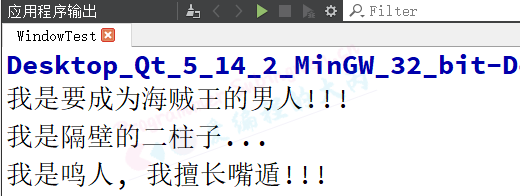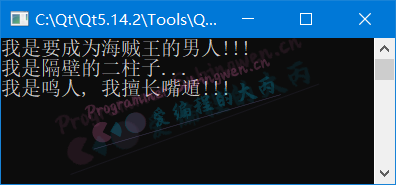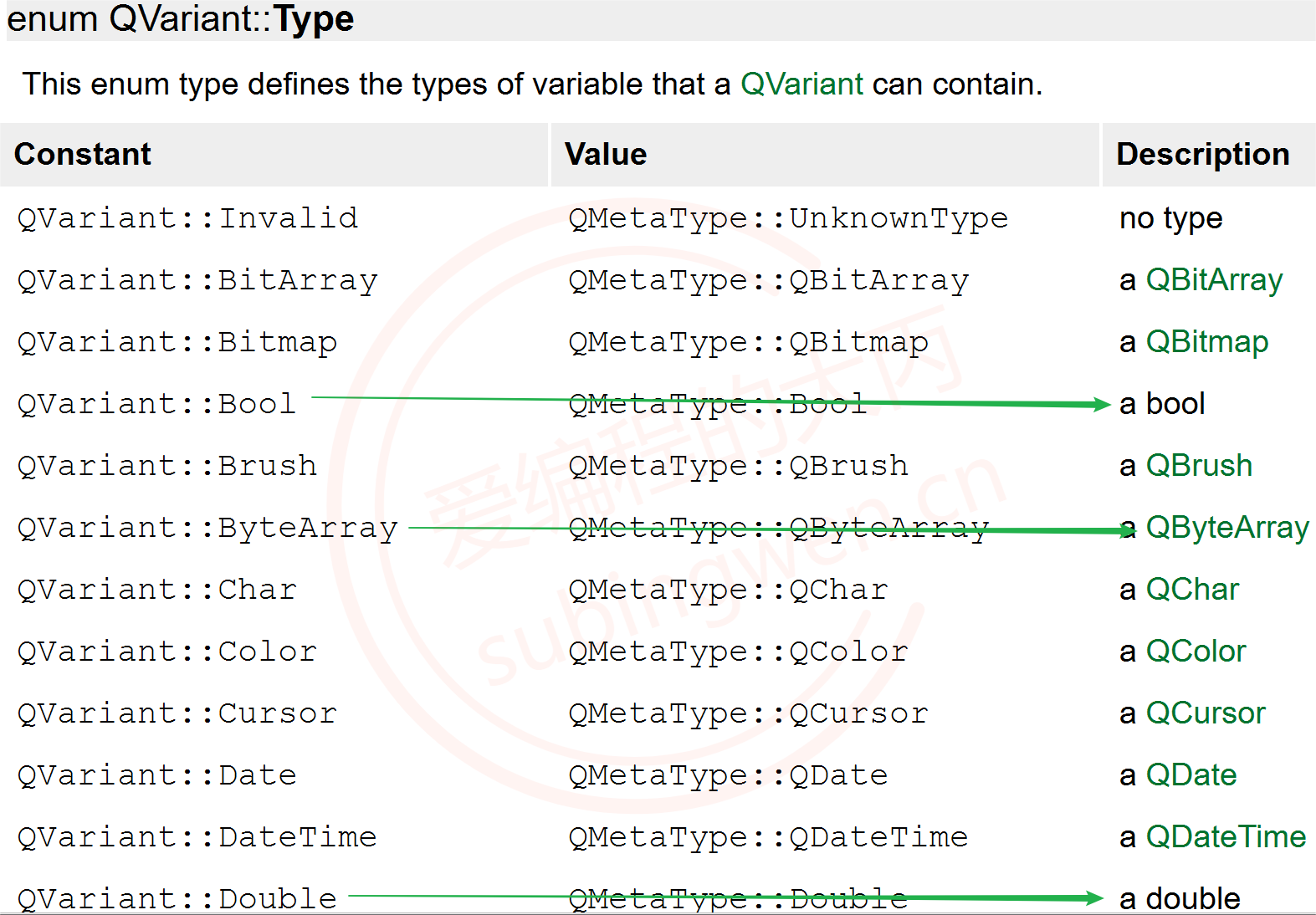Qt中的基础数据类型
内容摘要:文章中主要介绍了Qt中常用的数据类型, 主要内容包括: 基础数据类型, Log日志输出, 字符串类型, QVariant, 位置和尺寸相关类型, 日期和时间相关类型。 文章中除了关于知识点的文字描述, 还有相关的视频讲解,下面开始学习。。。
1. 基础类型
因为Qt是一个C++ 框架, 因此C++中所有的语法和数据类型在Qt中都是被支持的, 但是Qt中也定义了一些属于自己的数据类型, 下边给大家介绍一下这些基础的数类型。
QT基本数据类型定义在#include <QtGlobal> 中,QT基本数据类型有:
| 类型名称 | 注释 | 备注 |
|---|---|---|
| qint8 | signed char | 有符号8位数据 |
| qint16 | signed short | 16位数据类型 |
| qint32 | signed short | 32位有符号数据类型 |
| qint64 | long long int 或(__int64) | 64位有符号数据类型,Windows中定义为__int64 |
| qintptr | qint32 或 qint64 | 指针类型 根据系统类型不同而不同,32位系统为qint32、64位系统为qint64 |
| qlonglong | long long int 或(__int64) | Windows中定义为__int64 |
| qptrdiff | qint32 或 qint64 | 根据系统类型不同而不同,32位系统为qint32、64位系统为qint64 |
| qreal | double 或 float | 除非配置了-qreal float选项,否则默认为double |
| quint8 | unsigned char | 无符号8位数据类型 |
| quint16 | unsigned short | 无符号16位数据类型 |
| quint32 | unsigned int | 无符号32位数据类型 |
| quint64 | unsigned long long int 或 (unsigned __int64) | 无符号64比特数据类型,Windows中定义为unsigned __int64 |
| quintptr | quint32 或 quint64 | 根据系统类型不同而不同,32位系统为quint32、64位系统为quint64 |
| qulonglong | unsigned long long int 或 (unsigned __int64) | Windows中定义为__int64 |
| uchar | unsigned char | 无符号字符类型 |
| uint | unsigned int | 无符号整型 |
| ulong | unsigned long | 无符号长整型 |
| ushort | unsigned short | 无符号短整型 |
虽然在Qt中有属于自己的整形或者浮点型, 但是在变成过程中这些一般不用, 常用的类型关键字还是 C/C++中的 int, float, double 等。
2. log输出
2.1 在调试窗口中输入日志
在Qt中进行log输出, 一般不使用c中的
printf, 也不是使用C++中的cout, Qt框架提供了专门用于日志输出的类, 头文件名为QDebug, 使用方法如下:
1 | // 包含了QDebug头文件, 直接通过全局函数 qDebug() 就可以进行日志输出了 |
日志信息在IDE的调试窗口输出

2.2 在终端窗口中输出日志
使用上面的方法只能在项目调试过程中进行日志输出, 如果不是通过
IDE进行程序调试, 而是直接执行可执行程序在这种情况下是没有日志输出窗口的, 因此也就看不到任何的日志输出。默认情况下日志信息是不会打印到终端窗口的, 如果想要实现这样的效果, 必须在项目文件中添加相关的属性信息
打开项目文件(*.pro)找到配置项 config, 添加 console 控制台属性:
1 | CONFIG += c++11 console |
属性信息添加完毕,
重新编译项目日志信息就可以打印到终端窗口了

3. 字符串类型
在Qt中不仅支持
C,C++中的字符串类型, 而且还在框架中定义了专属的字符串类型, 我们必须要掌握在Qt中关于这些类型的使用和相互之间的转换。
| 语言类型 | 字符串类型 |
|---|---|
| C | char* |
| C++ | std::string, char* |
| Qt | QByteArray, QString 等 |
3.1 QByteArray
在Qt中
QByteArray可以看做是c语言中char*的升级版本。我们在使用这种类型的时候可通过这个类的构造函数申请一块动态内存,用于存储我们需要处理的字符串数据。下面给大家介绍一下这个类中常用的一些API函数,
大家要养成遇到问题主动查询帮助文档的好习惯。
构造函数
1
2
3
4
5
6
7// 构造空对象, 里边没有数据
QByteArray::QByteArray();
// 将data中的size个字符进行构造, 得到一个字节数组对象
// 如果 size==-1 函数内部自动计算字符串长度, 计算方式为: strlen(data)
QByteArray::QByteArray(const char *data, int size = -1);
// 构造一个长度为size个字节, 并且每个字节值都为ch的字节数组
QByteArray::QByteArray(int size, char ch);数据操作
1
2
3
4
5
6
7
8
9
10
11
12
13
14
15
16
17
18
19
20
21
22
23
24
25
26
27
28// 在尾部追加数据
// 其他重载的同名函数可参考Qt帮助文档, 此处略
QByteArray &QByteArray::append(const QByteArray &ba);
void QByteArray::push_back(const QByteArray &other);
// 头部添加数据
// 其他重载的同名函数可参考Qt帮助文档, 此处略
QByteArray &QByteArray::prepend(const QByteArray &ba);
void QByteArray::push_front(const QByteArray &other);
// 插入数据, 将ba插入到数组第 i 个字节的位置(从0开始)
// 其他重载的同名函数可参考Qt帮助文档, 此处略
QByteArray &QByteArray::insert(int i, const QByteArray &ba);
// 删除数据
// 从大字符串中删除len个字符, 从第pos个字符的位置开始删除
QByteArray &QByteArray::remove(int pos, int len);
// 从字符数组的尾部删除 n 个字节
void QByteArray::chop(int n);
// 从字节数组的 pos 位置将数组截断 (前边部分留下, 后边部分被删除)
void QByteArray::truncate(int pos);
// 将对象中的数据清空, 使其为null
void QByteArray::clear();
// 字符串替换
// 将字节数组中的 子字符串 before 替换为 after
// 其他重载的同名函数可参考Qt帮助文档, 此处略
QByteArray &QByteArray::replace(const QByteArray &before, const QByteArray &after);子字符串查找和判断
1
2
3
4
5
6
7
8
9
10
11
12
13
14
15
16
17// 判断字节数组中是否包含子字符串 ba, 包含返回true, 否则返回false
bool QByteArray::contains(const QByteArray &ba) const;
bool QByteArray::contains(const char *ba) const;
// 判断字节数组中是否包含子字符 ch, 包含返回true, 否则返回false
bool QByteArray::contains(char ch) const;
// 判断字节数组是否以字符串 ba 开始, 是返回true, 不是返回false
bool QByteArray::startsWith(const QByteArray &ba) const;
bool QByteArray::startsWith(const char *ba) const;
// 判断字节数组是否以字符 ch 开始, 是返回true, 不是返回false
bool QByteArray::startsWith(char ch) const;
// 判断字节数组是否以字符串 ba 结尾, 是返回true, 不是返回false
bool QByteArray::endsWith(const QByteArray &ba) const;
bool QByteArray::endsWith(const char *ba) const;
// 判断字节数组是否以字符 ch 结尾, 是返回true, 不是返回false
bool QByteArray::endsWith(char ch) const;遍历
1
2
3
4
5
6
7
8
9// 使用迭代器
iterator QByteArray::begin();
iterator QByteArray::end();
// 使用数组的方式进行遍历
// i的取值范围 0 <= i < size()
char QByteArray::at(int i) const;
char QByteArray::operator[](int i) const;查看字节数
1
2
3
4
5
6
7
8
9
10// 返回字节数组对象中字符的个数
int QByteArray::length() const;
int QByteArray::size() const;
int QByteArray::count() const;
// 返回字节数组对象中 子字符串ba 出现的次数
int QByteArray::count(const QByteArray &ba) const;
int QByteArray::count(const char *ba) const;
// 返回字节数组对象中 字符串ch 出现的次数
int QByteArray::count(char ch) const;类型转换
1
2
3
4
5
6
7
8
9
10
11
12
13
14
15
16
17
18
19
20
21
22
23
24
25
26
27
28
29
30
31// 将QByteArray类型的字符串 转换为 char* 类型
char *QByteArray::data();
const char *QByteArray::data() const;
// int, short, long, float, double -> QByteArray
// 其他重载的同名函数可参考Qt帮助文档, 此处略
QByteArray &QByteArray::setNum(int n, int base = 10);
QByteArray &QByteArray::setNum(short n, int base = 10);
QByteArray &QByteArray::setNum(qlonglong n, int base = 10);
QByteArray &QByteArray::setNum(float n, char f = 'g', int prec = 6);
QByteArray &QByteArray::setNum(double n, char f = 'g', int prec = 6);
[static] QByteArray QByteArray::number(int n, int base = 10);
[static] QByteArray QByteArray::number(qlonglong n, int base = 10);
[static] QByteArray QByteArray::number(double n, char f = 'g', int prec = 6);
// QByteArray -> int, short, long, float, double
int QByteArray::toInt(bool *ok = Q_NULLPTR, int base = 10) const;
short QByteArray::toShort(bool *ok = Q_NULLPTR, int base = 10) const;
long QByteArray::toLong(bool *ok = Q_NULLPTR, int base = 10) const;
float QByteArray::toFloat(bool *ok = Q_NULLPTR) const;
double QByteArray::toDouble(bool *ok = Q_NULLPTR) const;
// std::string -> QByteArray
[static] QByteArray QByteArray::fromStdString(const std::string &str);
// QByteArray -> std::string
std::string QByteArray::toStdString() const;
// 所有字符转换为大写
QByteArray QByteArray::toUpper() const;
// 所有字符转换为小写
QByteArray QByteArray::toLower() const;
3.2 QString
QString也是封装了字符串, 但是内部的编码为
utf8, UTF-8属于Unicode字符集,它固定使用多个字节(window为2字节, linux为3字节)来表示一个字符,这样可以将世界上几乎所有语言的常用字符收录其中。下面给大家介绍一下这个类中常用的一些API函数。
构造函数
1
2
3
4
5
6
7// 构造一个空字符串对象
QString::QString();
// 将 char* 字符串 转换为 QString 类型
QString::QString(const char *str);
// 将 QByteArray 转换为 QString 类型
QString::QString(const QByteArray &ba);
// 其他重载的同名构造函数可参考Qt帮助文档, 此处略数据操作
1
2
3
4
5
6
7
8
9
10
11
12
13
14
15
16
17
18
19
20
21
22
23
24
25
26
27
28
29
30
31
32
33
34
35
36// 尾部追加数据
// 其他重载的同名函数可参考Qt帮助文档, 此处略
QString &QString::append(const QString &str);
QString &QString::append(const char *str);
QString &QString::append(const QByteArray &ba);
void QString::push_back(const QString &other);
// 头部添加数据
// 其他重载的同名函数可参考Qt帮助文档, 此处略
QString &QString::prepend(const QString &str);
QString &QString::prepend(const char *str);
QString &QString::prepend(const QByteArray &ba);
void QString::push_front(const QString &other);
// 插入数据, 将 str 插入到字符串第 position 个字符的位置(从0开始)
// 其他重载的同名函数可参考Qt帮助文档, 此处略
QString &QString::insert(int position, const QString &str);
QString &QString::insert(int position, const char *str);
QString &QString::insert(int position, const QByteArray &str);
// 删除数据
// 从大字符串中删除len个字符, 从第pos个字符的位置开始删除
QString &QString::remove(int position, int n);
// 从字符串的尾部删除 n 个字符
void QString::chop(int n);
// 从字节串的 position 位置将字符串截断 (前边部分留下, 后边部分被删除)
void QString::truncate(int position);
// 将对象中的数据清空, 使其为null
void QString::clear();
// 字符串替换
// 将字节数组中的 子字符串 before 替换为 after
// 参数 cs 为是否区分大小写, 默认区分大小写
// 其他重载的同名函数可参考Qt帮助文档, 此处略
QString &QString::replace(const QString &before, const QString &after, Qt::CaseSensitivity cs = Qt::CaseSensitive);子字符串查找和判断
1
2
3
4
5
6
7
8
9
10
11// 参数 cs 为是否区分大小写, 默认区分大小写
// 其他重载的同名函数可参考Qt帮助文档, 此处略
// 判断字符串中是否包含子字符串 str, 包含返回true, 否则返回false
bool QString::contains(const QString &str, Qt::CaseSensitivity cs = Qt::CaseSensitive) const;
// 判断字符串是否以字符串 ba 开始, 是返回true, 不是返回false
bool QString::startsWith(const QString &s, Qt::CaseSensitivity cs = Qt::CaseSensitive) const;
// 判断字符串是否以字符串 ba 结尾, 是返回true, 不是返回false
bool QString::endsWith(const QString &s, Qt::CaseSensitivity cs = Qt::CaseSensitive) const;遍历
1
2
3
4
5
6
7
8// 使用迭代器
iterator QString::begin();
iterator QString::end();
// 使用数组的方式进行遍历
// i的取值范围 0 <= position < size()
const QChar QString::at(int position) const
const QChar QString::operator[](int position) const;查看字节数
1
2
3
4
5
6
7
8// 返回字节数组对象中字符的个数 (字符个数和字节个数是不同的概念)
int QString::length() const;
int QString::size() const;
int QString::count() const;
// 返回字节串对象中 子字符串 str 出现的次数
// 参数 cs 为是否区分大小写, 默认区分大小写
int QString::count(const QStringRef &str, Qt::CaseSensitivity cs = Qt::CaseSensitive) const;类型转换
1
2
3
4
5
6
7
8
9
10
11
12
13
14
15
16
17
18
19
20
21
22
23
24
25
26
27
28
29
30
31
32
33
34
35// 将int, short, long, float, double 转换为 QString 类型
// 其他重载的同名函数可参考Qt帮助文档, 此处略
QString &QString::setNum(int n, int base = 10);
QString &QString::setNum(short n, int base = 10);
QString &QString::setNum(long n, int base = 10);
QString &QString::setNum(float n, char format = 'g', int precision = 6);
QString &QString::setNum(double n, char format = 'g', int precision = 6);
[static] QString QString::number(long n, int base = 10);
[static] QString QString::number(int n, int base = 10);
[static] QString QString::number(double n, char format = 'g', int precision = 6);
// 将 QString 转换为 int, short, long, float, double 类型
int QString::toInt(bool *ok = Q_NULLPTR, int base = 10) const;
short QString::toShort(bool *ok = Q_NULLPTR, int base = 10) const;
long QString::toLong(bool *ok = Q_NULLPTR, int base = 10) const
float QString::toFloat(bool *ok = Q_NULLPTR) const;
double QString::toDouble(bool *ok = Q_NULLPTR) const;
// 将标准C++中的 std::string 类型 转换为 QString 类型
[static] QString QString::fromStdString(const std::string &str);
// 将 QString 转换为 标准C++中的 std::string 类型
std::string QString::toStdString() const;
// QString -> QByteArray
// 转换为本地编码, 跟随操作系统
QByteArray QString::toLocal8Bit() const;
// 转换为 Latin-1 编码的字符串 不支持中文
QByteArray QString::toLatin1() const;
// 转换为 utf8 编码格式的字符串 (常用)
QByteArray QString::toUtf8() const;
// 所有字符转换为大写
QString QString::toUpper() const;
// 所有字符转换为小写
QString QString::toLower() const;字符串格式
1
2
3
4
5
6
7
8
9
10
11
12
13
14
15// 其他重载的同名函数可参考Qt帮助文档, 此处略
QString QString::arg(const QString &a,
int fieldWidth = 0,
QChar fillChar = QLatin1Char( ' ' )) const;
QString QString::arg(int a, int fieldWidth = 0,
int base = 10,
QChar fillChar = QLatin1Char( ' ' )) const;
// 示例程序
int i; // 假设该变量表示当前文件的编号
int total; // 假设该变量表示文件的总个数
QString fileName; // 假设该变量表示当前文件的名字
// 使用以上三个变量拼接一个动态字符串
QString status = QString("Processing file %1 of %2: %3")
.arg(i).arg(total).arg(fileName);
4. QVariant
QVariant这个类很神奇,或者说方便。很多时候,需要几种不同的数据类型需要传递,如果用结构体,又不大方便,容器保存的也只是一种数据类型,而QVariant则可以统统搞定。
QVariant 这个类型充当着最常见的数据类型的联合。QVariant 可以保存很多Qt的数据类型,包括
QBrush、QColor、QCursor、QDateTime、QFont、QKeySequence、 QPalette、QPen、QPixmap、QPoint、QRect、QRegion、QSize和QString,并且还有C++基本类型,如int、float等。
4.1 标准类型
将标准类型转换为QVariant类型
1
2
3
4
5
6
7
8
9
10
11
12
13
14
15
16
17
18
19
20
21
22
23
24// 这类转换需要使用QVariant类的构造函数, 由于比较多, 大家可自行查阅Qt帮助文档, 在这里简单写几个
QVariant::QVariant(int val);
QVariant::QVariant(bool val);
QVariant::QVariant(double val);
QVariant::QVariant(const char *val);
QVariant::QVariant(const QByteArray &val);
QVariant::QVariant(const QString &val);
......
// 使用设置函数也可以将支持的类型的数据设置到QVariant对象中
// 这里的 T 类型, 就是QVariant支持的类型
void QVariant::setValue(const T &value);
// 该函数行为和 setValue() 函数完全相同
[static] QVariant QVariant::fromValue(const T &value);
// 例子:
QVariant v;
v.setValue(5);
QVariant v = QVariant::fromValue(5);
int i = v.toInt(); // i is now 5
QString s = v.toString(); // s is now "5"判断 QVariant中封装的实际数据类型
1
2// 该函数的返回值是一个枚举类型, 可通过这个枚举判断出实际是什么类型的数据
Type QVariant::type() const;返回值
Type的部分枚举定义, 全部信息可以自行查阅Qt帮助文档
将QVariant对象转换为实际的数据类型
1
2
3
4
5
6
7
8
9// 如果要实现该操作, 可以使用QVariant类提供的 toxxx() 方法, 全部转换可以参考Qt帮助文档
// 在此举列举几个常用函数:
bool QVariant::toBool() const;
QByteArray QVariant::toByteArray() const;
double QVariant::toDouble(bool *ok = Q_NULLPTR) const;
float QVariant::toFloat(bool *ok = Q_NULLPTR) const;
int QVariant::toInt(bool *ok = Q_NULLPTR) const;
QString QVariant::toString() const;
......
4.2 自定义类型
除了标准类型, 我们自定义的类型也可以使用
QVariant类进行封装,被QVariant存储的数据类型需要有一个默认的构造函数和一个拷贝构造函数。为了实现这个功能,首先必须使用Q_DECLARE_METATYPE()宏。通常会将这个宏放在类的声明所在头文件的下面, 原型为:
Q_DECLARE_METATYPE(Type)使用的具体步骤如下:
第一步: 在头文件中声明
1
2
3
4
5
6
7
8// *.h
struct MyTest
{
int id;
QString name;
};
// 自定义类型注册
Q_DECLARE_METATYPE(MyTest)第二步: 在源文件中定义
1
2
3
4
5
6
7
8
9
10
11
12MyTest t;
t.name = "张三丰";
t.num = 666;
// 值的封装
QVariant vt = QVariant::fromValue(t);
// 值的读取
if(vt.canConvert<MyTest>())
{
MyTest t = vt.value<MyTest>();
qDebug() << "name: " << t.name << ", num: " << t.num;
}
以上操作用到的QVariant类的API如下:
1 | // 如果当前QVariant对象可用转换为对应的模板类型 T, 返回true, 否则返回false |
5. 位置和尺寸
在QT中我们常见的 点, 线, 尺寸, 矩形 都被进行了封装, 下边依次为大家介绍相关的类。
5.1 QPoint
QPoint类封装了我们常用用到的坐标点 (x, y), 常用的 API如下:
1 | // 构造函数 |
5.2 QLine
QLine是一个直线类, 封装了两个坐标点 (两点确定一条直线)常用API如下:
1 | // 构造函数 |
5.3 QSize
在QT中
QSize类用来形容长度和宽度, 常用的API如下:
1 | // 构造函数 |
5.4 QRect
在Qt中使用
QRect类来描述一个矩形, 常用的API如下:
1 | // 构造函数 |
6. 日期和时间
6.1 QDate
QDate类可以封装日期信息也可以通过这个类得到日期相关的信息, 包括:年,月,日。
1 | // 构造函数 |
6.2 QTime
QTime类可以封装时间信息也可以通过这个类得到时间相关的信息, 包括:时,分,秒,毫秒。
1 | // 构造函数 |
6.3 QDateTime
QDateTime类可以封装日期和时间信息也可以通过这个类得到日期和时间相关的信息, 包括:年,月,日,时,分,秒,毫秒。其实这个类就是QDate和QTime这两个类的结合体。
1 | // 构造函数 |
7. 视频讲解
以上知识点对应的视频讲解可以关注 B站-爱编程的大丙
视频地址: https://www.bilibili.com/video/BV1Jp4y167R9










